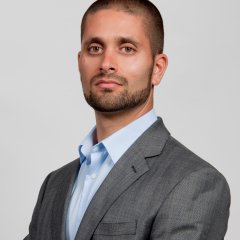Beeline Reader
In October, I wrote about MIT Solve’s Coastal Communities Challenge and provided some details on Solve Challenge Finals, Solve’s annual pitch event held in New York City on September 23. (Read that article here.)
In this follow-up piece, I’ll summarize four of the nine selected Solver solutions and their value propositions. These solutions focus on data collection, green coastal infrastructure, and support pre- and post-disaster resilience.
Green Stream
First, my favorite subject: data!
As a physicist, I’m always drawn to high-quality data sources, and Green Stream represents a well-implemented data capture system. Jim Gray, President & CEO, presented us with Green Stream’s data collection product, a connected sensor that uses sonic waves to measure water depth and integrates into a central data services platform. Green Stream’s sensors are currently deployed in Virginia and across the Carolinas, providing real-time data streams on flood depth over rivers, creeks, and flood-prone roadways.
This IoT device outperforms the traditional government tide and stream gauges at a fraction of the cost, enabling new levels of insight into geospatial flood risk. When leveraged by GPS route-planning software during emergency evacuation situations, it has the potential to save lives. The device connects to emergency services to improve their response ability and help target aid, and it triggers actions such as activating warning signs, road barriers, or drainage pumps.
The collected data can help inform mitigation efforts in the most frequently flooded areas. Insurance companies can leverage this data to increase claim payment speed and improve protection for auto and property lines.
To check out their technology, visit Green Stream’s website.
ISeeChange
While Green Stream’s data collection solution is entirely tech-based, ISeeChange couples a technology-enabled platform with stories and citizen science to raise situational awareness of climate change to support planning, community and municipal response, and decision making. After more than ten years reporting as a journalist on climate, environment, and science, ISeeChange founder Julia Kumari Drapkin recognized the power of networked observational data.
Julia’s app-driven platform continuously collects data across a variety of regions and parameters. Incorporating rain gauge and sensor data, digital images, and situational observations, ISeeChange’s localized projects track hard-to-monitor subjects ranging from urban flooding and heat, to changes in the growing season and biodiversity.
Much more than a data aggregation platform, ISeeChange’s equitable approach empowers local communities to share their personal stories about the impacts of climate events.
ISeeChange’s solution holds great potential for driving targeted responses and help in municipal planning, insurance outreach, customized resilience programs, and high-resolution data for climate response.
Learn more about ISeeChange and join the community.
GROW Oyster Reefs
The next two solutions focus on regenerating our natural defenses against coastal erosion and storm surge.
Question: Which metal contributes most to your body mass?
Answer: The same element that forms oyster shells and is used in constructing a significant portion of sea defences: calcium! (Our bones.)
GROW Oyster Reefs has developed a unique combination of a specialized concrete and substrate products that enables the formation of oyster reefs in appropriate estuaries.
This special recipe of cement, devised by GROW founder and serial entrepreneur Evelyn Tickle, is designed to be highly appealing to oysters, encouraging them to form reefs around GROW’s designs. These designs mimic natural forms, creating the opportunity to support the regeneration of oyster populations.
In centuries past, oysters were prevalent in many of the estuaries across the globe. They provided a useful breakwater that limited the negative impacts of strong waves by absorbing their energy. Waterway pollution, usually linked to industrial output, has reduced oyster populations in many of the world’s estuaries to very low levels; but if we follow the approaches proposed by GROW, we can regenerate these natural defenses.
Learn how they can transform the coastline.
Marauder Robotics
Last of these four solutions is Marauder Robotics. This company represents a nexus of technology that leverages submersible drones and real-time artificial vision to identify fauna, then deploys autonomous robotics and data aggregation to combat marine deforestation. Dennis Yancey, CEO, leads Marauder Robotics and is passionate about combating the march of an unassuming herbivore called the purple urchin.
The purple urchin is responsible for decimating kelp forests all along the northern California coastline. In the past, the urchin population explosion would have been curtailed by natural predators; due to a warming ocean, overfishing, and a confluence of natural phenomena, the purple urchin has devoured most of the kelp in this region.
Experiments conducted with human divers have demonstrated that by controlling the numbers of purple urchins, it’s possible to restore the kelp forests. So, Marauder One, a submersible drone, acts as an artificial predator to the purple urchin, maintaining their population at a level that gives kelp time to recover.
Not only does Marauder One provide benefits to other species dependent on kelp for survival, but the kelp forest benefits coastal communities in three ways: it provides a natural sea defense by dampening the impact that wave action and surge have on coastal erosion; it regenerates the ecosystem that supports economic activity through fishing and tourism; and there is a measurable reduction in ocean acidification in the area.
Learn more about the urchin overpopulation problem.
In my next post, I’ll summarize the remaining five Coastal Communities solutions. These innovations help communities adapt to climate change, combat pollution, and reduce greenhouse gas emissions. Stay tuned.
Dr Dennis Yancey Jr pitches Marauder Robotics during the Coastal Communities session at Solve Challenge Finals, September 23, 2018. Photo: Adam Schultz / MIT Solve






